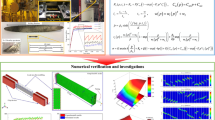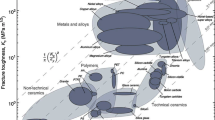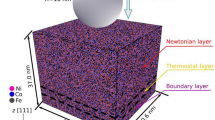Abstract
The Laasraoui-Jonas (LJ), Kocks-Mecking (KM), and power law (PW) stress–strain equations pertaining to hot working of metals within the range of moderate strains (i.e., before the occurrence of dynamic recrystallization) are compared. It is shown that it is not possible to select the “best” one to fit a given experimental flow curve, neither in the σ − ε nor in the \( {{{\text{d}}\rho } \mathord{\left/ {\vphantom {{{\text{d}}\rho } {{\text{d}}\varepsilon - \rho }}} \right. \kern-0pt} {{\text{d}}\varepsilon - \rho }} \) diagram. Noting that each of the three laws depends on two constitutive parameters, transformation formulae are then derived allowing the parameters of one law to be derived from the parameters of any of the two others. The fit of a given LJ equation by a PW law is then discussed. Finally, the transformation formulae are used to estimate the current rate of dynamic recovery when the flow rule is known in the form a PW law. The above theoretical derivations are illustrated by the specific case of a Fe-C alloy in the ferritic phase domain. However, they suggest that the conclusions are widely applicable to hot working of metals and alloys.







Similar content being viewed by others
References
Bergström Y (1970) A dislocation model for the stress-strain behaviour of polycrystalline (-Fe with special emphasis on the variation of the densities of mobile and immobile dislocations, Mater Sci Eng 5:193-200.
Y. Estrin and H. Mecking: Acta Metall., 1984, vol. 32, pp. 57–70.
Yoshie A, Morikawa H, Onoe Y, and Itoh K (1987) Formulation of static recrystallization of austenite in hot rolling process of steel plate, Trans ISIJ 27: 425–431.
Laasraoui A and Jonas JJ (1991) Prediction of steel flow stresses at high temperatures and strain rates, Metall Trans A 22:1545–1558.
Montheillet F, Lurdos O, and Damamme G (2009) A grain scale approach for modeling steady state discontinuous dynamic recrystallization, Acta Mater 57: 1602-1612.
F. Montheillet and J.J. Jonas: in Fundamentals of Modeling for Metals Processing, D.U. Furrer, L.S. Semiatin, eds., ASM Handbook, Materials Park, OH, 2009, vol. 22A, pp. 220–31.
Nes E (1998) Modelling of work hardening and stress saturation in FCC metals, Prog Mater Sci 41: 129-193.
Lin YC and Chen X (2011) A critical review of experimental results and constitutive descriptions for metals and alloys in hot working, Mater Des 32: 1733-1759.
Mülders B and Schubert F (2002) Modelling the large strain work hardening of commercial Al-alloy AA3004, Adv Eng Mater 4(4): 187-191.
Jorge Jr AM, Regone W, and Balancin O (2003) Effect of competing hardening and softening mechanisms on the flow stress curve modeling of ultra-low carbon steel at high temperatures, J Mater Proc Technol 142: 415-421.
H. Mecking and A. Beaudoin: in Fundamentals of Modeling for Metals Processing, D.U. Furrer and L.S. Semiatin, eds., ASM Handbook, Materials Park, OH, 2009, vol. 22A, pp. 458–71.
F. Montheillet and J. Le Coze: J. Phys., 2009, vol. 240, p. 012075.
Frost HJ and Ashby MF (1982) Deformation Mechanism Maps: The Plasticity and Creep of Metals and Ceramics. Pergamon Press, Oxford.
Poliak EI and Jonas JJ (1996) A one parameter approach to determining the critical conditions for the initiation of dynamic recrystallization, Acta Mater 44: 127–136.
C. Rossard: Ph.D. Dissertation, Métaux-Corrosion-Industries 35:102–115 (part 1), 140–153 (part 2), 190–205 (part 3), 1960.
Jonas JJ, Quelennec JJ, Jiang L, and Martin E (2009) The Avrami kinetics of dynamic recrystallization, Acta Mater 57:2748–2756.
Liu X, Li L, He F, Zhou J, Zhu B, and Zhang L (2013) Simulation on dynamic recrystallization behavior of AZ31 magnesium alloy using cellular automaton method coupling Laasraoui-Jonas model, Trans Nonferrous Met Soc China 23: 2692–2699.
Gourdet S and Montheillet F (2003) A model of continuous dynamic recrystallization, Acta Mater 51:2685–2699.
Acknowledgments
The authors are indebted to Pr. Cecilia Poletti, from Technische Universität Graz, Austria, for stimulating discussions and help for finalizing the paper.
Author information
Authors and Affiliations
Corresponding author
Additional information
Manuscript submitted October 17, 2013.
Rights and permissions
About this article
Cite this article
Montheillet, F., Piot, D., Matougui, N. et al. A Critical Assessment of Three Usual Equations for Strain Hardening and Dynamic Recovery. Metall Mater Trans A 45, 4324–4332 (2014). https://doi.org/10.1007/s11661-014-2388-9
Published:
Issue Date:
DOI: https://doi.org/10.1007/s11661-014-2388-9




